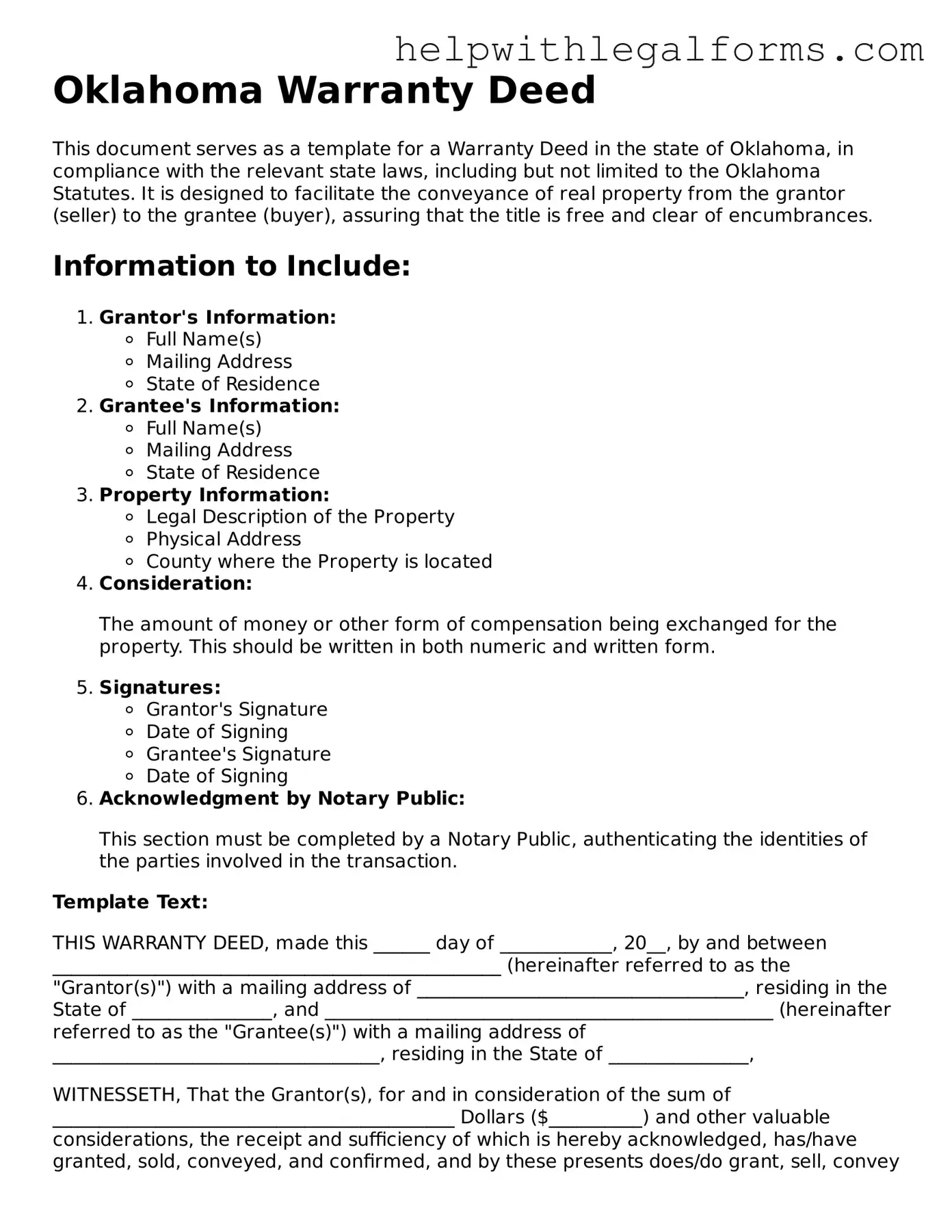Oklahoma Warranty Deed
This document serves as a template for a Warranty Deed in the state of Oklahoma, in compliance with the relevant state laws, including but not limited to the Oklahoma Statutes. It is designed to facilitate the conveyance of real property from the grantor (seller) to the grantee (buyer), assuring that the title is free and clear of encumbrances.
Information to Include:
- Grantor's Information:
- Full Name(s)
- Mailing Address
- State of Residence
- Grantee's Information:
- Full Name(s)
- Mailing Address
- State of Residence
- Property Information:
- Legal Description of the Property
- Physical Address
- County where the Property is located
- Consideration:
The amount of money or other form of compensation being exchanged for the property. This should be written in both numeric and written form.
- Signatures:
- Grantor's Signature
- Date of Signing
- Grantee's Signature
- Date of Signing
- Acknowledgment by Notary Public:
This section must be completed by a Notary Public, authenticating the identities of the parties involved in the transaction.
Template Text:
THIS WARRANTY DEED, made this ______ day of ____________, 20__, by and between ________________________________________________ (hereinafter referred to as the "Grantor(s)") with a mailing address of ___________________________________, residing in the State of _______________, and ________________________________________________ (hereinafter referred to as the "Grantee(s)") with a mailing address of ___________________________________, residing in the State of _______________,
WITNESSETH, That the Grantor(s), for and in consideration of the sum of ___________________________________________ Dollars ($__________) and other valuable considerations, the receipt and sufficiency of which is hereby acknowledged, has/have granted, sold, conveyed, and confirmed, and by these presents does/do grant, sell, convey and confirm unto the said Grantee(s), the following described real estate, situated in the County of ____________, State of Oklahoma, to-wit:
[Insert Legal Description of the Property Here]
TO HAVE AND TO HOLD the above described premises unto the said Grantee(s), their heirs, administrators, and assigns forever. And the Grantor(s) hereby covenants with the Grantee(s) that at the time of the execution of this conveyance, the Grantor(s) is/are lawfully seized in fee simple of the above-described premises, that the premises are free from all encumbrances, except as herein specifically set forth, and that the Grantor(s) will warrant and forever defend the same to the Grantee(s) against the lawful claims of all persons whomsoever.
IN WITNESS WHEREOF, the Grantor(s) has/have hereunto set their hand(s) and seal(s) the day and year first above written.
__________________________________
Grantor's Signature
__________________________________
Date
__________________________________
Grantee's Signature
__________________________________
Date
STATE OF OKLAHOMA
COUNTY OF ____________
On this ______ day of ____________, 20__, before me, a Notary Public in and for said State, personally appeared _________________________________________, known to me (or satisfactorily proven) to be the person(s) whose name(s) is/are subscribed to the within instrument, and acknowledged that he/she/they executed the same for the purposes therein contained.
IN WITNESS WHEREOF, I have hereunto set my hand and official seal.
__________________________________
Notary Public
My Commission Expires: ____________
